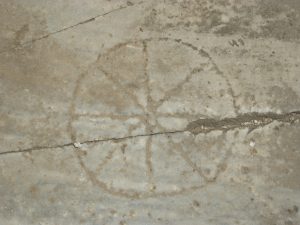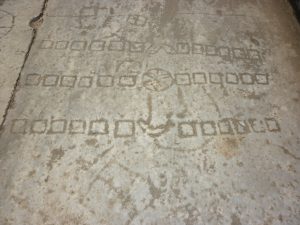Glenn Maffia (with valuable research by Jay Jean Jackson)
CLIMBING the stairs to the vastly impressive front façade of the Temple will bring one into the Pronaos, an area allowing the petitioners to await the answers to their questions received by the god of prophecy.
It was here the priests of Apollo’s shrine pulled back the massive doors of the Cresmographeion to announce those cryptic words of knowledge and wisdom relayed via the priestess deep within the holy inner sanctum.
I shall discuss these rituals at a later date, but for this article the focus is on the massed petitioners in the Pronaos and some curious engravings.
A game of religion
Carved on the marble flagstones you can see a multitude of circular incised graffiti within which straight lines cut the circle into 8 equal segments (I’ve counted 28, but there may be more lurking under the grime).
Tour guides dubiously refer these as ‘ichthys’ – Christian symbols. Granted, their identical appearance is, indeed, indisputable.
Though an ‘ichthys’ is a symbol made from using the first letter of each word in Greek:-
 ΙΧΘΥΣ (Ἰησοῦς Χριστός, Θεοῦ Υἱός, Σωτήρ. Latin script: Iēsous Christos, Theou Yios, Sōtēr).
ΙΧΘΥΣ (Ἰησοῦς Χριστός, Θεοῦ Υἱός, Σωτήρ. Latin script: Iēsous Christos, Theou Yios, Sōtēr).
The English translates as, “Jesus Christ, Son of God, Saviour”.
Overlaying these Greek letters upon one another results in the circle dissected by 8 equal segments.
Separately these initial letters also spell ‘fish’ in Greek, which relates to another esteemed Christian symbol: Jesus’ alleged occupation as a fisherman of Galilee.
Though, there are clues as to their true identity. Noticeably the sheer number of them proliferate the floor space of the Pronaos. None are found upon a wall, for example.

Surely such clandestine Christian symbols within a magnificent and high profile pagan temple their daring would be all the more pronounced within the eyeline of the attended people. All are found on the floor. Why?
A religion of gaming
Simply, these deeply inscribed scratches are clearly some kind of game, possibly played with dice and counters.
A very human activity to while away the time awaiting the priestess to consult the god, and then the priest scribes to arrange them into hexameter verse (all replies from Apollo were given in hexameter form at Didyma) before the doors were opened.

Hunt games were extremely popular in ancient times, therefore, it appears, to me, given the circularity, the games belong in that chase category: whether they were Hare and Foxes, Bear and Hounds, etc.
Closer inspection reveals there are distinct variations of the shapes within the circle, some of which are impressively complex. These variations in no way resemble the Christian symbol ‘ichthys’.
If any more confirmation were needed then this game is not the only one to be inscribed upon the flagstones.
There is an extremely famous example, just to one’s right once one has ascended the stairs.
A very obvious precursor of backgammon, the Romans called this game ‘Ludus duodecimo scriptorum’. A literal translation of this name is “game of twelve markings”, which refers to the three rows of twelve features upon the playing area.
The game was played with three dice which determined the movement of the 15 pieces each player had available.
Therefore, taking the human aspect as logical evidence over a religious zealot’s belief containing no evidence whatsoever, we have a clear example of how our ancestors simply passed the time with their compatriots.
